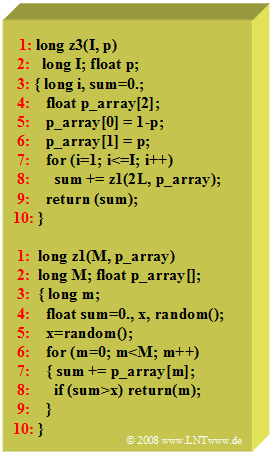Difference between revisions of "Aufgaben:Exercise 2.7Z: C Program "z3""
From LNTwww
| Line 4: | Line 4: | ||
[[File:EN_Sto_Z_2_7.png|right|frame| C program $z3$ for generating <br>a binomial distribution]] | [[File:EN_Sto_Z_2_7.png|right|frame| C program $z3$ for generating <br>a binomial distribution]] | ||
| − | The C program $z3$ given | + | The C program $z3$ given here successively generates a binomially distributed random variable with the characteristic variables $I$ and $p$. |
*It uses the program $z1$ already described and analyzed in [[Aufgaben:Exercise_2.7:_C_Programs_"z1"_and_"z2"|Exercise 2.7]] . | *It uses the program $z1$ already described and analyzed in [[Aufgaben:Exercise_2.7:_C_Programs_"z1"_and_"z2"|Exercise 2.7]] . | ||
*Assume that the program is called with parameters $I = 4$ and $p = 0.75$ . | *Assume that the program is called with parameters $I = 4$ and $p = 0.75$ . | ||
*The first eight real-valued numbers (all between zero and one) generated by the random generator $\text{random()}$ are: | *The first eight real-valued numbers (all between zero and one) generated by the random generator $\text{random()}$ are: | ||
:$$\rm 0.75, \ 0.19, \ 0.43, \ 0.08, \ 0.99, \ 0.32, \ 0.53, \ 0.02.$$ | :$$\rm 0.75, \ 0.19, \ 0.43, \ 0.08, \ 0.99, \ 0.32, \ 0.53, \ 0.02.$$ | ||
| − | |||
| − | |||
| − | |||
| − | |||
| Line 20: | Line 16: | ||
Hints: | Hints: | ||
*The exercise belongs to the chapter [[Theory_of_Stochastic_Signals/Generation_of_Discrete_Random_Variables|Generation of Discrete Random Variables]]. | *The exercise belongs to the chapter [[Theory_of_Stochastic_Signals/Generation_of_Discrete_Random_Variables|Generation of Discrete Random Variables]]. | ||
| − | *Reference is also made to the chapter [[Theory_of_Stochastic_Signals/Binomial_Distribution| | + | *Reference is also made to the chapter [[Theory_of_Stochastic_Signals/Binomial_Distribution|Binomial distribution]]. |
| Line 29: | Line 25: | ||
{Which of the following statements are true? | {Which of the following statements are true? | ||
|type="[]"} | |type="[]"} | ||
| − | + $z3$ returns a binomially distributed random variable, because several binary values are summed up. | + | + $z3$ returns a binomially distributed random variable, because several binary values are summed up. |
| − | + To pass parameters to the program $z1$, the array $\text{p_array} = \big [1-p, \ \ p \big]$ is used. | + | + To pass parameters to the program $z1$, the array $\text{p_array} = \big [1-p, \ \ p \big]$ is used. |
| − | + Passing of $M=2$ must be done with "$\rm 2L$", because $z1$ expects a long (data type) value. | + | + Passing of $M=2$ must be done with "$\rm 2L$", because $z1$ expects a long (data type) value. |
| − | {What value will be output on <u>first call</u> of $z3$ ? | + | {What value will be output on the <u>first call</u> of $z3$ ? |
|type="{}"} | |type="{}"} | ||
$z3 \ = \ $ { 2 } | $z3 \ = \ $ { 2 } | ||
| − | {What value will be output on <u>second call</u> of $z3$ ? | + | {What value will be output on the <u>second call</u> of $z3$ ? |
|type="{}"} | |type="{}"} | ||
$z3 \ = \ $ { 3 } | $z3 \ = \ $ { 3 } | ||
Revision as of 15:55, 29 December 2021
The C program $z3$ given here successively generates a binomially distributed random variable with the characteristic variables $I$ and $p$.
- It uses the program $z1$ already described and analyzed in Exercise 2.7 .
- Assume that the program is called with parameters $I = 4$ and $p = 0.75$ .
- The first eight real-valued numbers (all between zero and one) generated by the random generator $\text{random()}$ are:
- $$\rm 0.75, \ 0.19, \ 0.43, \ 0.08, \ 0.99, \ 0.32, \ 0.53, \ 0.02.$$
Hints:
- The exercise belongs to the chapter Generation of Discrete Random Variables.
- Reference is also made to the chapter Binomial distribution.
Questions
Solution
(1) All three statements are true.
(2) The real-valued random numbers $0.75$, $0.19$, $0.43$ and $0.08$ are each compared with $0.25$ .
- This comparison results in the binary values $1, \ 0, \ 1, \ 0$.
- This results in the sum $\underline{z3 = 2}$ in the first call.
(3) Analogous to the result of the subtask (2) the binary values $1, \ 1, \ 1, \ 0$ now occur because of the random values $0.99$, $0.32$, $0.53$ and $0.02$ .
- This leads to the output value $\underline{z3 = 3}$ (again sum of binary values).
